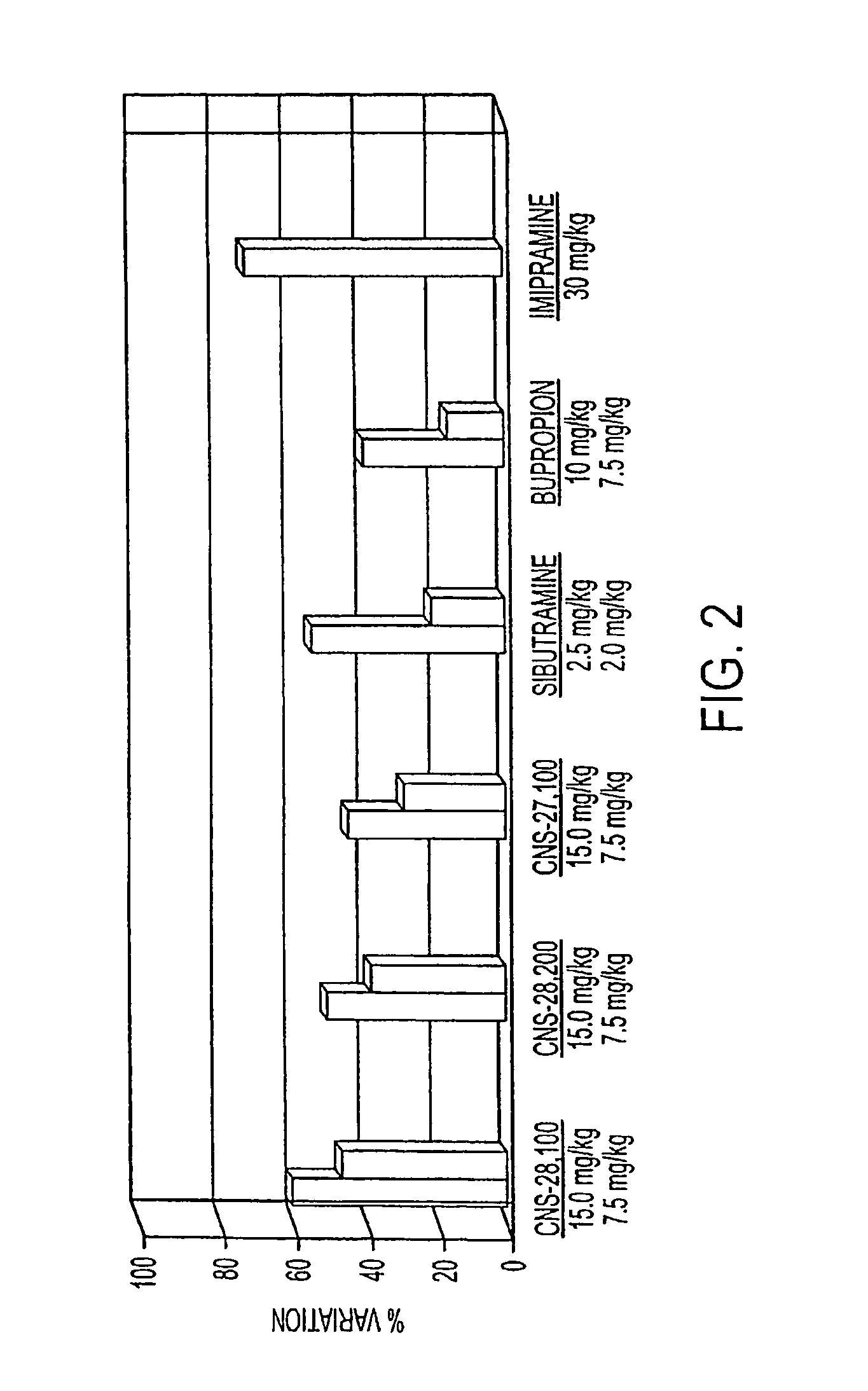Dopamine transporter inhibitors for use in treatment of movement disorders and other CNS indications
a technology of dopamine transporter and inhibitor, which is applied in the direction of drug composition, metabolism disorder, instruments, etc., can solve the problems of relative excess of acetylcholine, disruption of the function of the affected area, and inability as well as distress, so as to improve the function performance
- Summary
- Abstract
- Description
- Claims
- Application Information
AI Technical Summary
Benefits of technology
Problems solved by technology
Method used
Image
Examples
example 1
Antagonism of Dopamine Receptors or Transporters & Functional Activity
[0302]Functional activity of the compounds was determined in vitro in cellular assays using recombinant human cell lines. Measurements of functional activity for serotonine uptake inhibition was determined in human HEK-293 cell lines according to the procedures of Gu et al. (J. Biol. Chem. 269: 27124, 1994) using fluoxetine (EC50=57 nM) as the reference compound. Determination of functional activity for norephinephrine uptake inhibition was accomplished using an MDCK cell line according to the methods of Galli et al. (J. Exp. Biol. 198: 2197, 1995) with desipramine (EC50=7 nM) as a reference compound. For determination of dopamine functional activity, a hDAT cell line was used as described by Giros et al. (Mol. Pharmacol. 42: 383, 1992) with nomifensine (EC50=11 nM) as a reference compound.
[0303]
TABLE IIn Vitro Selectivity - Functional Uptake ProfilesCNS-CNS-CNS-R-28,10027,10028,001R-DDMSDMSHUMANDAT (nM)11510030EC...
example 2
In Vivo Efficacy of Several Illustrative Dopamine Transporter Inhibitors
[0318]In vivo efficacy of several illustrative DAT inhibitors of the instant invention, CNS-27,100, CNS-28,100, and CNS-28,200, were measured using standard forced swim test model using rat. The objective of this study was to assess the antidepressant effects of test compounds in the behaviral despair assay in rats using a modification of a method described by Porsolt R. D. et al. in Behavioral despair in rats: a new model sensitive to antidepressant treatment, Eur. J. Pharmacol., 47: 379-391, 1978; Porsolt et al., Nature 266: 730-732, 1977; and Porsolt et al., in Psychopharmacology, Olivier, Mos, and Slangen (eds) Birkhauser Verlag, Basel, pp. 137-159, 1991. Briefly, when mice (or rats) are forced to swim in a cylinder from which no escape is possible, they readily adopt a characteristic immobile posture and make no further attempts to escape except for small movements needed to keep floating. The immobility is...
example 3
Toxicological Profiles of Illustrative Dopamine Transporter Inhibitors
[0327]An in vivo evaluation was carried out to determine the maximum tolerated dose of numerous test compounds in rat. The compounds were administered i.v., and the animals were then observed for 72 hours.
[0328]Table V summarizes the acute single-dose toxicological profile data for three DAT inhibitors of the instant invention, CNS-27,100, CNS-28,002, and CNS-28,200.
[0329]
TABLE VAcute Single-Dose Toxicological ProfilesAcute Single DoseToxicologyCNS-27,100CNS-28,002CNS-28,200RAT 30 mg / kgNoNoNo(n = 5)SignificantSignificantSignificantSymptomsSymptomsSymptoms 90 mg / kgNoNoNoSignificantSignificantSignificantSymptomsSymptomsSymptoms120 mg / kgNoNoDecrease gripSignificantSignificantstrength andSymptomsSymptomslimb tone andconvulsions200 mg / kgDecrease gripNoConvulsionsstrength.SignificantSlight depression.Symptoms
[0330]Briefly, experimental rats, in groups of 5 animals, were administered with various doses of respective DAT ...
PUM
| Property | Measurement | Unit |
|---|---|---|
| volume | aaaaa | aaaaa |
| hydrogen pressure | aaaaa | aaaaa |
| pH | aaaaa | aaaaa |
Abstract
Description
Claims
Application Information
 Login to View More
Login to View More - R&D
- Intellectual Property
- Life Sciences
- Materials
- Tech Scout
- Unparalleled Data Quality
- Higher Quality Content
- 60% Fewer Hallucinations
Browse by: Latest US Patents, China's latest patents, Technical Efficacy Thesaurus, Application Domain, Technology Topic, Popular Technical Reports.
© 2025 PatSnap. All rights reserved.Legal|Privacy policy|Modern Slavery Act Transparency Statement|Sitemap|About US| Contact US: help@patsnap.com



